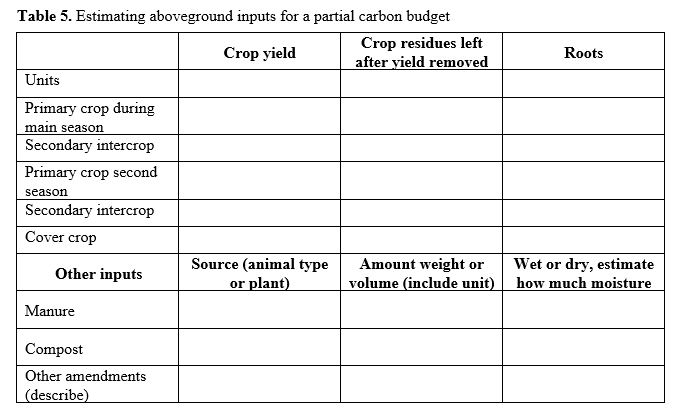You are here
Partial Carbon Budget
As mentioned, soil carbon is a balance between the inputs of organic materials and the decomposition of SOM. A complete budget for carbon is difficult to measure or estimate, but an estimate of a partial budget would tell if similar or lower levels of carbon are going into the soil relative to that of a natural system. This can indicate whether the soil carbon levels should be increasing or decreasing compared to the natural system and among treatments. Soil disturbance such as tillage would also reduce the soil carbon relative to no- or reduced-till practices. Organic (carbon) inputs to the soil include those internal to the system (i.e., root litter and aboveground litter, including that of cover crops and the return of crop residues), and inputs external to the system (i.e., manure, composts, other forms of biomass transfer).
The scale of analysis is generally at the field level, but can be applied to the farm and landscape scales with appropriate sampling strategies and mapping.
How to operationalize the metric
Method of data collection and data needed to compute the method:
Method for estimating a partial carbon budget
1. Measure or ask the farmer the area of the plot which will be assessed. This is an essential step: to calculate the amount of carbon added on a rate basis, you need to know area to which it is applied.
Size of plot_______
2. Above ground biomass inputs:
a. Indicate or ask the farmer the primary and secondary crops (if any) that were harvested from the field in season one (and two if there is a second season). Indicate if a cover crop/green manure was grown for biomass, not grain yield. Record responses in the table below.
b. Measure or ask the farmer the yield obtained from each crop grown in the plot and record responses in the table below.
c. Measure or ask the farmer the biomass of the cover crop or vegetative fallow.
d. For manure or compost calculate the amount per area (kg/ha or t/ha) of the material that was applied. Note: for each of these materials it will be necessary to estimate the percent water content and report all on a dry-weight basis. If crop residues are not measured or estimated by the farmer, then estimate the amount of residue based on the harvest index (grain/grain + biomass) for each crop.
e. Estimate of above-ground inputs to the plot by summing the values from steps 2a, 2b, 2c, and 2d above: ___________
3. Make corrections for root inputs, organic input management, and tillage practices.
a. Estimating below-ground inputs is extremely difficult. Obtain some type of qualitative comparison by going through the various above-ground inputs and indicating which ones would also contribute to below-ground inputs (e.g., crops, cover crops, vegetative fallows).
Crops: roots (yes or no)
Cover crops (yes or no)
Other vegetative fallow (yes or no)
b. For each yes response above, give a score of 1, otherwise a score of 0.
c. Sum the scores from above. Total + _______.
4. Indicate or ask the farmer if the plot was managed with tillage (-1), reduced tillage (0), or no or minimum tillage (1).
5. Indicate or ask for each of the inputs if it was incorporated into the soil (yes=1, no=0) or left on the soil surface as mulch (yes=1, no=0)
Crop residues (of each crop type): ________________
Compost: __________________
Animal manure (and what type): _______________
Others: ____________________
6. Sum the numbers for root inputs, tillage practices, and inputs obtained above in steps 3, 4, and 5: ___________
Summary of and comparison of organic inputs.
- Obtain an estimate of net primary productivity (NPP) from maps or estimates of potential yields + biomass (also from maps).
- Compare the amount of organic inputs to the plot with that of the NPP or potential yield plus biomass.
- Correct the comparison based on the root inputs and soil management practices calculated in 3 above by giving the number in parentheses next to the total inputs (example: if there was 5 ton/ha inputs in one treatment with a total of 4 for the modifiers, give it a 5 ton/ha (4); another plot might also have input of 5 t/ha but no modifiers to give 5 t/ha (0)
- Compare the treatments and the NPP and give a qualitative ranking to the amount of soil carbon that would result from the treatments – NPP is usually the highest and given a 1.
Unit of analysis:
Content here
Limitations regarding estimating and interpreting:
Content here


